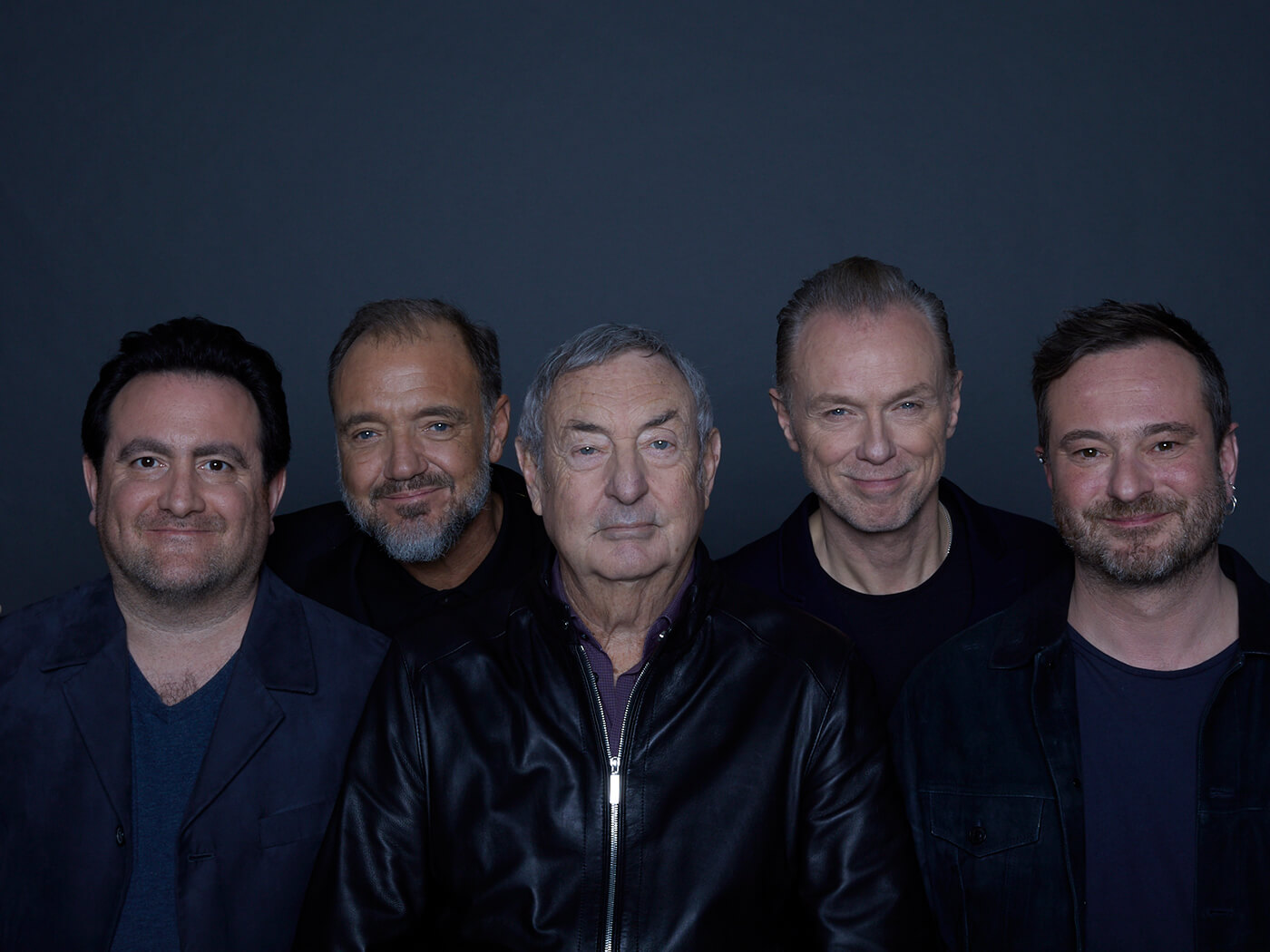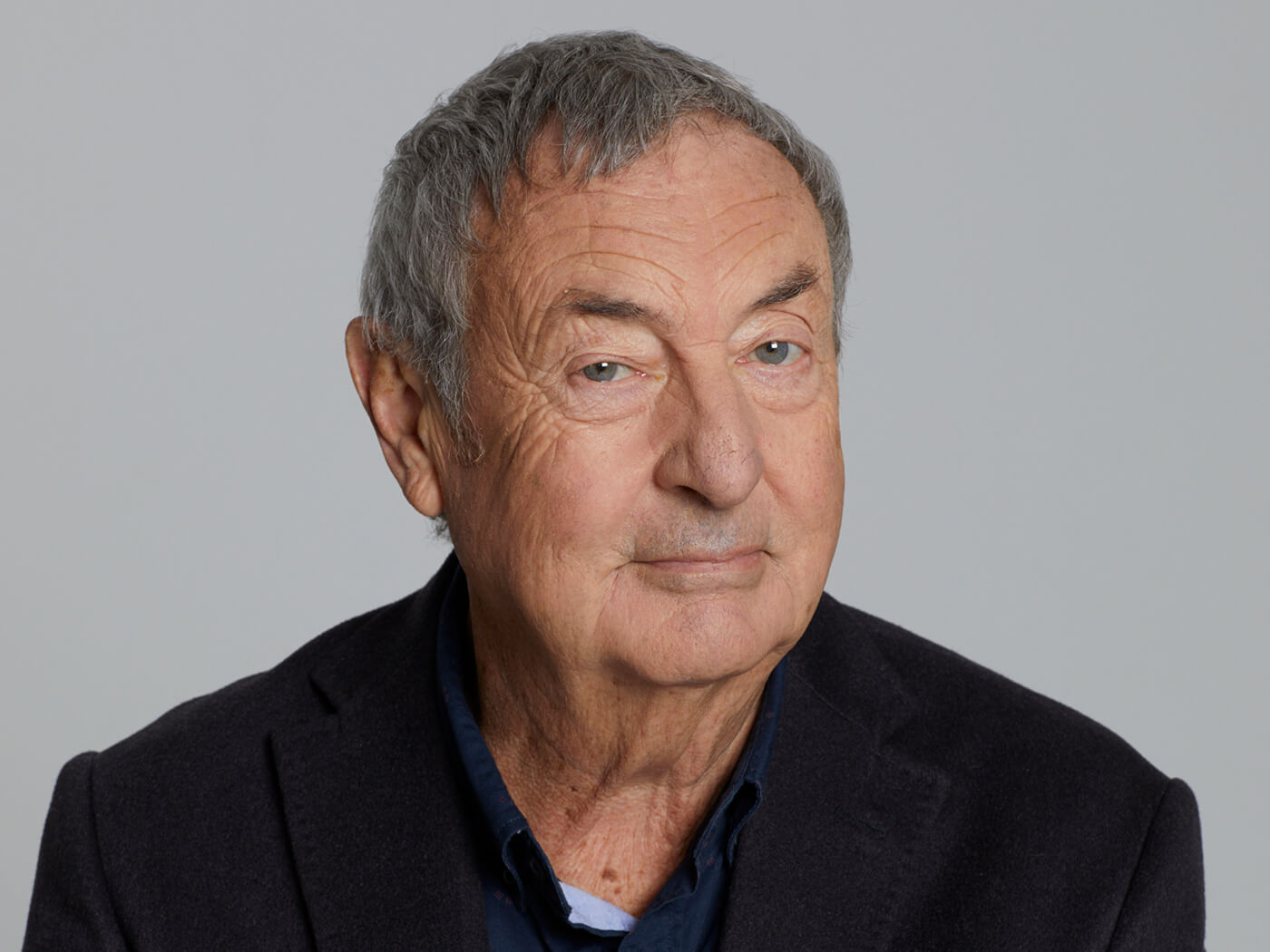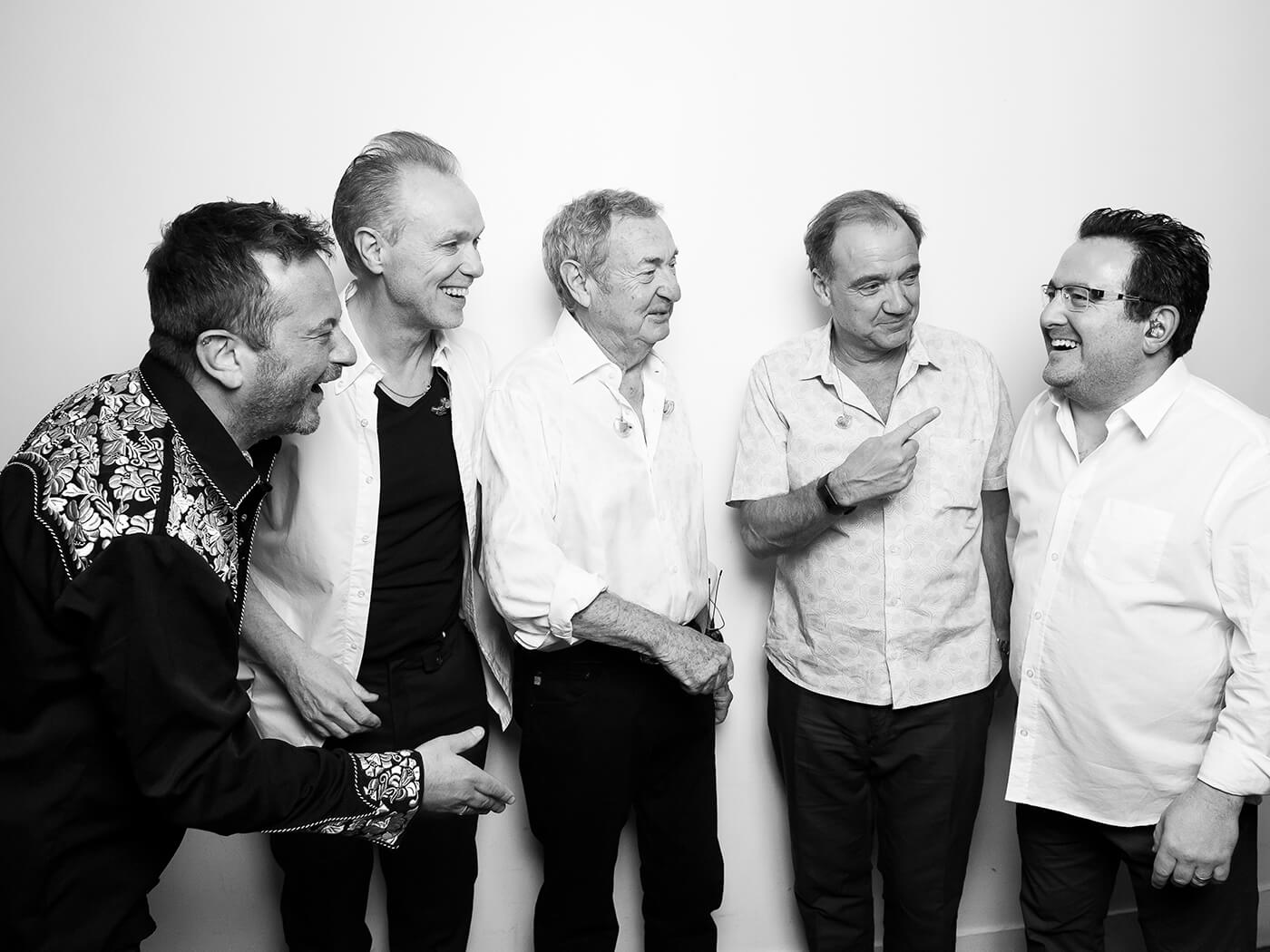“We have to soak up all this music and try and make it our own!” the all-star cast taking on Pink Floyd in Nick Mason’s Saucerful of Secrets
Former Floyd drummer Mason has assembled an unlikely cast of supporting cast to help him bring Pink Floyd’s early psychedelic music back to the stage, featuring members of The Orb, The Blockheads and… Spandau Ballet?

Image: Paddy Balls / Martin Grififn
Back in 2018, the news that Pink Floyd drummer Nick Mason was assembling a band – named Saucerful of Secrets – dedicated to bringing life to the music of early Pink Floyd (including much of Syd Barrett’s work) sent a psychedelic ripple through the music world.
Perhaps as intriguing as the rare and precious repertoire was the personnel, an line-up of talented musicians pulled from disparate ends of the UK music scene including alumni of Floyd, The Orb, The Blockheads and… Spandau Ballet?!
We caught up with the Saucerful Of Secrets stringed section – comprising Lee Harris and Gary Kemp on guitars and super bassman Guy Pratt – to find out, “Why has it all got to be so terribly loud?”

A lot has changed since your first proof of concept gigs at Dingwalls and The Half Moon in London. What was your approach to preparing for those initial live shows?
Lee Harris: “I had put together a plan with a list of songs and when we actually got together in the rehearsal studios it was very much a ‘best of early Pink Floyd’. At the start we assumed Gary do most of the singing, so I ran every choice past him. Nick just wanted to get out and play the drums so he wasn’t that fussy about song choice. In the end it just worked!”
Gary Kemp: As soon as we played Lucifer Sam for the first time it all sort of fell into place! Guy and I couldn’t help moving, it felt like a Dr Feelgood track! And the big riffs in something like Arnold Lane and See Emily Play are more like The Who and The Kinks. There are only five of us so we have to fill more of the stage and we wanted to play it loud!
“There are so many outfits playing this music. You know, David Gilmour has got his thing going with a lot of musicians on stage, a lot of people looking at the floor as well… People have been social distancing in Pink Floyd bands for decades!
“Roger Waters has a similar sort of approach although he’s more god-like, obviously and sort of prowls around the stage. Then there are all the professional tribute bands with their massive lighting systems and black t-shirts staying very still – it came up in conversation in those first rehearsals, we cannot wear black t-shirts!
“In the early days Nick was a heavier drummer – you’ve only got to watch Live In Pompeii to see how his presence on stage was right up front! It was about that energy and noise – we have to move, to soak up all this music and then try and make it our own!”
Guy Pratt: “This is the 3rd Pink Floyd project I’ve been involved with in 35 years with the band. Pink Floyd, David Gilmour and now this! Well, I have actually played with Roger Waters, too, but he doesn’t know about the last time because I was hiding behind the wall…
“At the start I was the common link between everyone and the other band members didn’t know each other. Saucerful Of Secrets is different from pretty much anything I’ve ever done since my first band. It feels like a team and the shows are approached as a team effort. It’s basic for a Pink Floyd related thing but obviously it’s still very hi-tech by most people’s standards!”

You have access to a world of instruments and equipment that early Pink Floyd could only dream about. How did you select what to use to make this music on stage?
GK: “Our intention was not to go back and find all the original gear and try and get the sound exactly right. We weren’t going to be like some sort of Early Music orchestra where you’re only allowed to play Crumhorns. Let’s be honest – it’s too high risk now to go on a worldwide tour with ancient Binson Echorecs, something’s going to die half-way so that inevitably means an element of digital gear.
GP: “It’s worth remembering that what early Floyd did was only barely achievable at the time with the equipment they had. Technology does allow us to recreate what early Pink Floyd sounded like in the studio which is a luxury they never had! That said you know, I’ve got this fucking huge great pedalboard and one does take liberties…”
LH: “I live in France so prior to the first tour I ordered a load of new equipment and had it sent through to the UK. That meant the only way I could get acquainted with all my new toys was to get into the studio early before rehearsals so I could have the place to myself and really crank things up. But then people would arrive early or the drum tech would be setting up and sound checking – it was mayhem. Consequently, I wasn’t really happy with my guitar sound until about two weeks into the tour when it all started to gel. Now I can’t wait to get back out there!”
GK: “Lee and I spent ages discussing the effects and guitars and how they would blend together for different songs listening to delay timings and different distortions. Occasionally though we want it to sound big and modern too! Syd Barrett’s guitar style had a massive influence on modern music. He inspired Mick Ronson, Pete Townshend to some extent, and of course David Gilmour for years! Syd began that sound, the looped, bucket echo type stuff that David then picked up on and made his own thing. Without Syd there have been no John Martyn, there would be no The Edge.”

Let’s talk guitars – obviously Pink Floyd has become synonymous with some iconic instruments. What are you taking out with you?
LH: “The one thing I didn’t want to do was play a fucking black Strat just like everyone in all the tribute bands, and I’ve seen enough people playing their nice Les Pauls on these songs for me to feel a little done with that approach. I just got my gold Strat because of the colour, then I realised I’m in a band with Gary who wrote Gold! So, yeah, I didn’t think that one through… And now I’ve got the gold Telecaster. I see a theme. Oh and everything is strung with La Bellas.
“I saw H.E.R playing an acrylic Strat at the Grammys and I thought I’d love one of those. I remember seeing Nile Rogers with an acrylic guitar, probably a Dan Armstrong, and I always wanted one. So I emailed Fender and because I was in France the email went to the European office who said, ‘Sorry, we can’t do that, it was made as a one-off and there are no plans to make this as a production model’ so I wrote back and said, ‘Yes, I know that, but I’d like to get one please!’
“Eventually it all came together and it looks fucking amazing – although I can’t help thinking it would have looked even better when I was 20 years younger and didn’t have a belly on the other side of the acrylic!”
GK: “I’m using my main Strat, a 1979 I bought in 1981 – there’s a Duncan humbucker by the bridge now, there’s a piezo in there too although I don’t use that for this band. I played that guitar on all of the Spandau hits and I absolutely love it. There’s my 1971 Tele which I picked up a few years ago that seemed to really suit this gig. I also use a Martin New Yorker nylon-string which replaces the original cello part in Atom Heart Mother. The idea of having a Martin on a stand was very exciting to me, I’ve wanted to do that since I saw Steve Howe do it in the early 1970s – I thought, ‘Fuck what a great idea, that’s proper prog!’ So it’s all come full circle!
GP: “I do try to be as authentic as possible guitar-wise so everything from 1967-69 is played on a Rickenbacker and anything from 1969 to ’72 is on a Precision. There are a couple of songs, like Fearless, that were never actually played live, so it doesn’t matter if I use a Jazz there. I quite like not taking irreplaceable guitars on tour if I can avoid it so I’m actually playing one of my Bass Centre ‘Betsy’ signature recreations.
“There had to be something slightly whimsical of course – a while back Warwick were insisting on giving me a new bass and I couldn’t think of anything I wanted at the time so I went “Alright, fuck it, give us a Buzzard!” [the wildly shaped model designed in conjunction with John Entwistle – Ed]
“So I got this thing, basically just for entertainment value, but then we started doing Let There Be More Light and I thought, ‘If there is ever, ever going to be a time when a Warwick Buzzard is the appropriate choice then it’s right now!’
“It’s a preposterous thing and it’s just perfect for that song. It even makes you stand like John Enwistle! There is no guitar stand on earth that you can put it on, no case it fits in, it’s a fucking nightmare for the crew! John Entwistle said that he designed the shape so you could hook it over the back of a stool to change the strings which is a lovely idea but seeing as he hadn’t changed a set of strings since 1966, is neither here nor there.”
The music of early Pink Floyd is fertile ground for the use of mind-bending guitar textures. What exotic boxes are you using at the moment?
LH: “This has been a closely guarded secret but I checked and I can talk to you about it now – I’ve been working with Adrian Thorpe of Thorpy Effects to develop a pedal based on the Selmer Treble and Bass amp that Syd used. Thorpy was able to get hold of an original to work from and he had a prototype ready in weeks. We’re calling it the Scarlet Tunic and it’s basically the ultimate psychedelic foundation overdrive.
“My main fuzz is now a handmade Silicon Phuzz by Phil Robinson Advanced Circuitry in England which is just wonderful. It has a circuit in it which stops it getting brittle when you add other pedals – very handy. The overblown speaker sounds in See Emily Play and The Nile Song came from a Catalinbread Karma Suture for a while but now I’ve got a Pete Cornish NG3, as one does… All that goes into a Hi-Tone amp.
GK: “When we first started I was playing through a Lazy J which was great but didn’t have enough meat to it for this particular show. That’s when I switched to the Hiwatts. Naturally, the pedalboards have grown as we’ve progressed. I started off with a very small bunch of effects, mostly separate Pete Cornish pedals into Strymons and when we started playing larger theatres I went back to my main Pete Cornish board he built for me in 2015 for a big Spandau tour. This is my third board from Pete, the first one which I bought in 1984 was stolen years ago and I’ve got no idea where it ended up. That was one of the flat models that took up half the stage…
“I link up my Cornish board to another board full of Strymons – Timelines, Mobius, Big Sky that sort of thing, which are driven by a Disaster Area MIDI controller programmed with a different set of modulations and textures for every song. There’s also a Whammy pedal which I use on Set The Controls and then I use it again at the end of Interstellar Overdrive where it all just goes ‘Neeeeeeeooooowwwww’ and drops down into chaos. I like using expression pedals with the Strymons during a song to create washes of effects.
“I don’t use a looper in the Cornish board- I’ve got four or five different distortions, a Tube Driver and then the rest are Pete’s own recipe as well as an old Boss chorus. I actually enjoy the choreography of the pedal work and Pete’s boards are so well made, everything is well laid-out and the switches are at exactly the right height, I never get the worry that I’m going to miss a pedal at an important time. They’re very clear and well-lit. I hope you’re interested in all that shit!”
In the new Live At The Roundhouse DVD you are using a stand-mounted board to create all kinds of glorious chaos. What’s going on there?
GK: “First of all I’m not telling you what’s on the stand, everyone asks and it’s my little secret. Obviously it’s the sort of shit that�’s going to self-oscillate when you push it, all feeding back. When we did the first pub gigs I had a delay unit on the top of my amp so during those parts of the show I thought I’d get some effects going and get wild. But that meant I had my back to the audience. So when we decided we’d go out and do this properly it just occurred to me that it would be fun to have a kind of Van de Graaf generator, kind of thing going on at the front. Almost like Jimmy Page and his theremin.
“I’m just enormously thrilled that at 60 years old I’m getting the opportunity to surprise people. Certainly, joining an element of Pink Floyd and becoming part of the Pink Floyd family after my history with Spandau was nothing if not a great surprise to the majority of discerning, tasteful and sensitive Floyd heads out there!”

Pink Floyd fans are known for a deep and abiding attachment to the band and its music, do you feel the weight of that expectation from audiences around the world?
GP: “No! Quite the opposite in fact! It’s got to the point playing with David Gilmour, take the second solo to Comfortably Numb as an example, I look out over the audience and it’s like a religious gathering! It’s like Lourdes: a mass of people who have come to be absolved of their sins and cured – I mean, it’s some fucking guitar solo!
With a Saucers audience it’s more a case of, ‘I never thought I would hear this music played live in my life!’ To me it feels like a rehumanising of Pink Floyd – taking it back to when it was a pop group rather than this vast, faceless monolith!
You know, we had a band Zoom call last week and it was so sweet, it felt like a real band. Well, not a real band – real bands fucking hate each other!”
Nick Mason was unavailable for comment for this feature as he was tending to a new-born lamb.
Live At The Roundhouse is out now.
